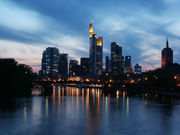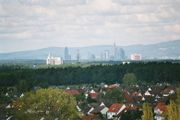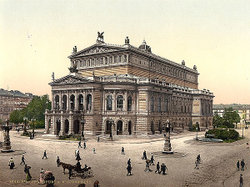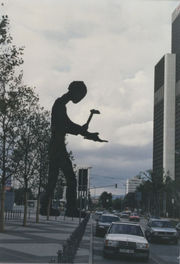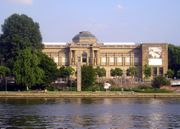Frankfurt
2007 Schools Wikipedia Selection. Related subjects: European Geography
| Frankfurt am Main | |
|---|---|
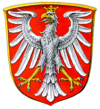 |
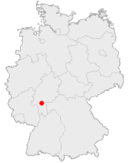 |
|
|
|
| Country | Germany |
| State | Hesse |
| Administrative region | Darmstadt |
| District | urban district |
| Population | 648,325 source (mid-2005) |
| Area | 248.31 km² |
| Population density | 2,611 / km² |
| Elevation | 112 m |
| Coordinates | 50°7′ N 8°41′ E |
| Postal code | 60001-60599, 65901-65936 |
| Area code | 069, 06109, 06101 |
| Licence plate code | F |
| Mayor | Petra Roth ( CDU) |
| Website | frankfurt.de |
Frankfurt am Main [ˈfraŋkfʊrt] is the largest city in the German state of Hesse and the fifth-largest city in Germany after Berlin, Hamburg, Munich and Cologne, with an estimated mid-2005 population of 648,325. The Frankfurt urban area, which extends beyond the city boundaries, had an estimated population of 1,468,140 in 2000. The city is at the centre of the larger Frankfurt Rhine Main Area which has a population of 5 million and is Germany's second largest metropolitan area.
Situated on the Main river, Frankfurt is the financial and transportation centre of Germany. Frankfurt is the seat of the European Central Bank, the Frankfurt Stock Exchange and is one of the two largest financial centres in continental Europe (the other one being Paris). According to the Liverpool University, Frankfurt is the wealthiest city in the European Union as measured by GDP per capita. It is also listed as one of nine Alpha world cities.
Among English speakers the city is commonly known simply as "Frankfurt", though Germans sometimes call it by its full name to distinguish it from the other Frankfurt in the German state of Brandenburg, known as Frankfurt (Oder). It was once called Frankfort-on-the-Main in English, a translation of Frankfurt am Main.
Overview
Frankfurt has played a central role in the political history of Germany and the German states for centuries. From 855 to 1792 Frankfurt was the electoral city for the Emperors of the Holy Roman Empire of the German Nation. In the 1848-49 revolutions, it became a sort of revolutionary capital and was the seat of the first democratically elected German parliament, the Frankfurt Parliament, which met in the Frankfurter Paulskirche, or the St. Paul's Church.
The three pillars of Frankfurt's economy are finance, transport, and trade fairs. Frankfurt has been Germany's financial capital for centuries, and it is the home of a number of major banks and brokerages. The Frankfurt Stock Exchange is Germany's largest, and one of the world's most important. Frankfurt houses the European Central Bank, which sets monetary policy for the Eurozone economy, and the German Bundesbank. It also houses a number of major commercial banks, including Deutsche Bank, Dresdner Bank, and Commerzbank.
Frankfurt has an excellent transportation infrastructure and a major international airport and European transportation hub, the Frankfurt International Airport. Frankfurt Airport ranks among the world's top ten airports and serves 304 flight destinations in 110 countries.Depending whether total passengers or flights are used to measure, it ranks as the second or third busiest in Europe alongside London Heathrow Airport and Paris' Charles de Gaulle. Its central location at Europe's heart and its excellent accessibility by air, rail and road make Frankfurt Airport City especially attractive. In addition, many large trade fairs take place in Frankfurt each year, notably the Internationale Automobil-Ausstellung (Frankfurt Motor Show) and the Frankfurt Book Fair, which have far over 100,000 visitors each, but also important special interest fairs like the LinuxWorld Conference & Expo or Musikmesse Frankfurt.
Frankfurt is often nicknamed "Bankfurt", "Mainhattan" (derived from the local Main River) or "The Big Äppel" (named for its apple wine industry). It is one of only four European cities that have a significant number of high-rise skyscrapers. With eleven skyscrapers taller than 150 m (492 ft) in 2004, Frankfurt is second behind Paris ( La Défense and Montparnasse, with twelve skyscrapers taller than 150 m, not counting the Eiffel Tower), but ahead of London ( Canary Wharf and the City, with eight skyscrapers taller than 150 m) and Moscow (seven skyscrapers taller than 150 m). The city of Frankfurt contains the tallest skyscraper in the European Union, the Commerzbank Tower, which is also the second tallest on the continent (after the Triumph-Palace building in Moscow).
Frankfurt is also home to many cultural and educational institutions, the Johann Wolfgang Goethe-Universität, many museums, most of them lined up along the Main river on the Museumsufer (museum embankment), and a large botanical garden, the Palmengarten. Frankfurt's second major university, Business School of Finance and Management, focuses on finance. The best-known museums are das Städelsche Kunstinstitut und Städtische Galerie, called Städel, and the Senckenberg Natural History Museum. Others include the Museum for Modern Art, the Schirn Art Gallery, museums for architecture, movies, communications and the Jewish Museum / Museum Judengasse.
During World War II Frankfurt was heavily bombed and its medieval city centre was destroyed. The city recovered relatively quickly after the war, and its modern shape was formed. Part of the rebuilding process involved creating one of Europe's most efficient underground transportation systems in the 1970's. That system includes a subway train system ( S-Bahn) capable of reaching outlying communities as well as the city centre, and a deep subway with smaller coaches ( U-Bahn) also capable of traveling above ground on street rails.
History
In the area of the Römer, Roman settlements were established, probably in the first century; some artifacts from that era are found to this day. The city district Bonames has a name probably dating back to Roman times — it is thought to be derived from bona me(n)sa. Nida (Heddernheim) was also a Roman civitas capital.
The name of Frankfurt on the Main is derived from the Franconofurt of the Germanic tribe of the Franks; Furt ( cf. English ford) denotes a low point passage across a stream or river. Alemanni and Franks lived there and by 794 Charlemagne presided over an imperial assembly and church synod, at which Franconofurd (-furt -vurd) is first mentioned. However, since frank is also an old German word for frei ("free"), Frankfurt was a "free ford," an opportunity to cross the river Main without paying a toll.
In the Holy Roman Empire, Frankfurt was one of the most important cities. From 855 the German kings and emperors were elected in Frankfurt and crowned in Aachen. From 1562 the kings/emperors were also crowned in Frankfurt, Maximilian II being the first one. This tradition ended in 1792, when Franz II was elected. He was crowned, on purpose, on Bastille Day, 14 July, the anniversary of the storming of the Bastille. The elections and coronations took place in St. Bartholomäus cathedral, known as the Kaiserdom (en: Emperor's Cathedral), or in its predecessors.
The Frankfurter Messe (en: Frankfurt trade fair) was first mentioned in 1150. In 1240, Emperor Friedrich II granted an Imperial privilege to its visitors, meaning they would be protected by the Empire. Since 1478 book trade fairs have been held in Frankfurt, the Frankfurter Buchmesse being still the most important in Germany and, some might say, the world.
In 1372 Frankfurt became a Reichsstadt (en: Imperial city), i.e. directly subordinate to the Holy Roman Emperor and not to a regional ruler or a local nobleman.
Frankfurt managed to remain neutral during the Thirty Years' War, but it suffered from the bubonic plague that was brought to the city by refugees. After the end of the war, Frankfurt regained its wealth.
In the Napoleonic Wars Frankfurt was occupied or cannonaded several times by French troops. It nevertheless still remainded a free city until the total collapse of the Holy Roman Empire in 1805/6. In 1806 it become part of the principality of Aschaffenburg under the Fürstprimas (' Prince-Primate', 25 July 1806 – 19 October 1813: Karl Theodor Anton Maria Kämmerer von Worms, Reichsfreiherr von Dalberg (b. 1744 – d. 1817), 1803–1806 Prince-archbishop of Regensburg). This also meant, that Frankfurt was incorporated into the confederation of the Rhine. In 1810 Dalberg adopted the title of a Grand Duke of Frankfurt. Napoleon intended to make his adopted son Eugène de Beauharnais, already prince de Venise (" prince of Venice", a newly established primogeniture in Italy) Grand Duke of Frankfurt after Dalberg's death (since the latter as a Catholic bishop didn't have legitimate heirs). The Grand Duchy remained a short episode lasting from 1810 to 1813, when military tide turned in favor of the Anglo-Prussian lead allies, which turns over the Napoleonic order of central Europe. Dalberg abdicated in favour of Eugène de Beauharnais, which of course was only a symbolic action, as the latter effectively never did rule after the ruin of the French armies and Frankfurt being taken by the allies!
After Napoleon's final defeat and abdication, the Congress of Vienna (1812-1815, redrawing the map of Europe) dissolved the grand-duchy, and Frankfurt entered the newly founded German Confederation (till 1866) as a free city, becoming the seat of its Bundestag, the confederal parliament where the nominally presiding Habsburg Emperor of Austria was represented by an Austrian "presidential envoy".
After the ill-fated revolution of 1848, Frankfurt was home to the first German National Assembly (Nationalversammlung), which resided in St. Paul's Church (Paulskirche) (see German Confederation for details) and was opened on 18 May 1848. The institution failed in 1849 when the Prussian king declared that he would not accept "a crown from the gutter". In the year of its existence, the assembly developed a common constitution for a unified Germany, with the Prussian king as its monarch.
Frankfurt lost its independence after Austro-Prussian War as Prussia annexed in 1866 several smaller states, among them the free city of Frankfurt. The Prussian administration incorporated Frankfurt into its province of Hesse-Nassau. The formerly independent towns of Bornheim and Bockenheim were incorporated in 1890.
In 1914 the citizens of Frankfurt founded the University of Frankfurt, later called Johann Wolfgang Goethe University. This is the only civic foundation of a university in Germany; today it is one of Germany's largest universities.
After World War I Frankfurt was occupied by French troops as a means of reprisal, because the French found the German side guilty of having violated in some details the clauses of the peace treaty of Versailles concerning the demilitarisation of the Rhineland.[Quote from source requested on talk page to verify interpretation of source] In 1924 Ludwig Landmann became the first Jewish Mayor of the city, and led a significant expansion during the following years. However, during the Nazi era, the synagogues of Frankfurt were destroyed.
The city of Frankfurt was severely bombed in World War II. About 5 500 residents were killed during the raids, and the once famous medieval city centre, by that time the largest in Germany, was destroyed. The reconstruction after the war took place in an (often-simple) modern style, thus irrevocably changing the architectural face of Frankfurt. Only very few landmark buildings have been reconstructed historically, albeit in a simplified manner.
After the end of the war Frankfurt became a part of the newly founded state of Hesse, consisting of the old Hesse-(Darmstadt) and the Prussian Hesse provinces. Frankfurt was the original choice for the provisional capital of West Germany — they even went as far as constructing a new parliament building that has never been used for its intended purpose, and is now a TV studio. In the end, Konrad Adenauer (the first post-war Chancellor) preferred the tiny city of Bonn, for the most part because it was close to his hometown, but also for another reason; many other prominent politicians opposed the choice of Frankfurt out of concern that Frankfurt, one of the largest German cities, and a former centre of the old German-dominated Holy Roman Empire, would be accepted as a "permanent" capital of Germany, thereby weakening the West German population's support for reunification and the eventual return of the capital city to Berlin.
Population
Frankfurt is a multicultural city. Most immigrants are from Turkey, the former Yugoslavia, or Italy. The Frankfurt Area is also home to the largest Korean community in Europe. 180 different nationalities reside in Frankfurt.
For a long time Frankfurt was a Protestant-dominated city. However, during the 19th century an increasing number of Catholics moved to the city. Today a narrow plurality of citizens are Catholic. Frankfurt has the second largest Jewish community (after Berlin) in Germany.
Geography
Geographic location
The city is located on both sides of the Main River. The southern part of the city contains the Frankfurt City Forest (Frankfurter Stadtwald) Germany's largest urban forest. The centre of Frankfurt is located on the north of Main River.
Neighbouring communities and areas
To the West, Frankfurt borders the Main-Taunus district (Towns and Municipalities Hattersheim am Main, Kriftel, Hofheim am Taunus, Kelkheim (Taunus), Liederbach am Taunus, Sulzbach (Taunus), Schwalbach am Taunus and Eschborn); to the Northwest the Hochtaunuskreis (Towns Steinbach (Taunus), Oberursel (Taunus), and Bad Homburg v.d. Höhe; to the North the Wetteraukreis (Towns Karben and Bad Vilbel); to the Northeast the Main-Kinzig district (Municipality Niederdorfelden and the town Maintal); to the Southeast the city Offenbach am Main; to the South the Offenbach district (Town Neu-Isenburg); and to the Southwest the Groß-Gerau district (Towns Mörfelden-Walldorf, Rüsselsheim und Kelsterbach).
City divisions and districts
The city is divided into 46 Stadtteile or Ortsteile which is again divided into 118 Stadtbezirke or city districts. The largest Ortsteil in area is Sachsenhausen-Süd. Most Stadtteile are incorporated suburbs, or Vororte, or previously separate cities. Some like Nordend arose during the rapid growth of the city in the Gründerzeit after the unification of Germany. Others were formed from settlements, which previously belonged to other city divisions, like Dornbusch (Frankfurt am Main).
The 46 city divisions are combined into 16 area districts or Ortsbezirke, which each have a district committee and chairperson.
History of incorporation
Until the middle of the 19th century, the city territory of Frankfurt consisted of the present-day Stadtteile of Altstadt, Innenstadt, Bahnhofsviertel, Gutleutviertel, Gallusviertel, Westend, Nordend, Ostend and Sachsenhausen. After 1877, a number of previously independent areas were incorporated into the city, see list of current districts of the city.
Sights
Cathedral
Saint Bartholomeus' Cathedral (Dom Sankt Bartholomäus) is a Gothic building, which was constructed in the 14th and 15th centuries on the foundation of an earlier church from the Merovingian time. It is the main church of Frankfurt. From 1356 onwards, kings of the Holy Roman Empire were elected in this church, and from 1562 to 1792, emperors were crowned here.
Since the 18th century, Saint Bartholomeus' has been called "the cathedral" by the people, although it has never been a bishop's seat. In 1867, the cathedral was destroyed by a fire and rebuilt in its present style. The height of the cathedral is 95 m.
Römer
The name of the town hall means "Roman". In fact, nine houses were acquired by the city council in 1405 from a wealthy merchant family. The middle house became the town hall and was later connected with the neighbouring buildings. In the upper floor, there is the Kaisersaal ("Emperor's Hall") where the newly crowned emperors held their banquets.
The Römer was partially destroyed in World War II, and later rebuilt.
Saint Paul's Church
St. Paul's Church (Paulskirche) is a national historic monument in Germany with great political symbolism, because it was the seat of the first democratically elected Parliament in 1848. It was established in 1789 as a Protestant church but was not finished until 1833. Its importance has its root in the Frankfurt Parliament, which met in the church during the revolutionary years of 1848/49 in order to write a constitution for a united Germany. The attempt failed because the monarchs of Prussia and Austria did not want to lose power, and in 1849 Prussian troops ended the democratic experiment by force of arms and the parliament was dissolved. Afterwards, the building was used for church services again.
St. Paul's was partially destroyed in World War II, particularly the interior of the building, which now has a modern appearance. It was quickly and symbolically rebuilt after the war; today it is not used for religious services, but mainly for exhibitions and events.
Concert House Old Opera
Alte Oper, Frankfurt's famous opera house, was built in 1880 by the architect Richard Lucae. It was one of the major opera houses of Germany, until it was destroyed in World War II. It was not until 1981 that the old opera was fully rebuilt and reopened. Today it functions as a concert hall, while operas are performed in the Oper Frankfurt. The inscription on the frieze of the Old Opera says: "Dem Wahren, Schönen, Guten" ("To the true, the beautiful, the good").
Frankfurt Opera
The Oper Frankfurt is the leading opera company of Germany and one of the most important opera houses in the world.
20th century architecture
- IG Farben Building
- New Frankfurt, housing estates 1925-1930
- Museum für angewandte Kunst, designed by Richard Meier
Skyscrapers
Frankfurt is unique for its skyscrapers, and it is one of only a few European cities to allow skyscrapers within the old central part of town. Along with Paris and London, it also is one of the few European cities to have a significant number of skyscrapers.
The major skyscrapers are:
- Commerzbank Tower — Europe's tallest building (1997–2005), designed by Sir Norman Foster.
- Silver Tower
- MesseTurm — Europe's tallest building (1990–1997)
- Kronenhochhaus (DZ-Bank) with its "statue of liberty" like roof structure.
- Maintower, among others "Landesbank Hessen-Thüringen" (HeLaBa)
- Trianon (Frankfurt am Main).
Other structures
- Henninger Turm
- a grain silo owned by Henninger Brewery with observation deck and restaurant, offering a breath-taking view over downtown Frankfurt from its south shore. The tower has been closed to the public since October 31, 2002.
- Europaturm
- a telecommunications tower known as the "Frankfurt TV Tower". Until 1999, it was open to the public, with an entertainment establishment in the revolving top.
Culture
Festivals
Frankfurt hosts several festivals, fairs, and carnivals throughout the year. The most famous is the Rheingau-Music-Festival with many (mostly classical) concerts at castles and under the open sky surrounded by vineyards. It's an annual festival, taking place in May. Another major festival in the city is the "Museumsuferfest"; "Museum-Riverbank-Festival". It is one of the biggest cultural festivals in Germany, which offers the opportunity to see, buy, smell, taste and hear new things from all around the world. The festival takes place yearly at the end of summer and attracts an average of 3 million visitors. The festival goes over a period of 3 days and ends with a spectacular show of fireworks. Frankfurt is also known for having one of the largest red light districts in Germany in vicinity of the Hauptbahnhof (main railway station).
Museums
- Städel
- Senckenberg Natural History Museum
- The Museum for Modern Art (Frankfurt am Main)
- Schirn Art Gallery
- Deutsches Filmmuseum
- Deutsches Architektur Museum
- Museum für angewandte Kunst Frankfurt, Museum of Design
- Deutsches Ikonenmuseum
- Museum für Kommunikation
Culinary specialties
- Frankfurter Sausage
- Frankfurter Rindswurst
- Apfelwein
- Grüne Soße
- Bethmännchen
- Frankfurter Kranz
- Handkäs mit Musik
- Rippchen mit Kraut
Transport
Airports
The city is accessed from around the world via the Frankfurt International Airport. The airport has three runways and is one of the three busiest airports in Europe, along with London Heathrow Airport and Charles de Gaulle International Airport. Frankfurt can also be accessed via Frankfurt-Hahn Airport which is located approximately 120 km from the actual city.
Railways
Frankfurt Hauptbahnhof recently underwent a major development to allow trains from all over Germany to arrive at the station. Long distance trains run by Deutsche Bahn exit and arrive at the station everyday and less luxurious EuroCity and InterCity trains do the same. The Airport Long Distance Station is one a modern station for the ICE highspeed trains at the Airport beside the A3 Motorway.
Local trains are integrated in the Public transport system Rhein-Main-Verkehrsverbund (RMV), second largest integrated public transport systems in the world. Only the Berlin integrated public transport system (VBB) is larger.
Public Transport
The city comprises of two underground railway systems which are U-Bahn and S-Bahn as well as an above-ground tram system known as the Straßenbahn. Information about the U and S Bahn can be found on the RMV website.
The S-Bahn is a far more extensive rail network which is above ground for the majority of the journey, however become subterranean in the city centre. The S-Bahn accesses the suburbs of Frankfurt and the main airport, as well as cities and larger towns in close distance (like Darmstadt, Hanau and Wiesbaden) as well as most towns on the way.
The U-Bahn has seven lines which serve the city centre and some larger suburbs. The trains that run on the line are in fact lightrails as many lines break to ground surface and travel along an own track in the middle of the street to the end. Just one line rns always in the underground.
The Straßenbahn only operates within the direct city centre of Frankfurt and some smaller suburbs, making it a popular option for mid-day business commuting. It also provides extensive access to area of Sachsenhausen located on the southern bank of the Main river.
A number of bus lines complete the public transportation system of Frankfurt. Night buses take over the service of the U-Bahn and Strassenbahn at 1:30 AM.to 3:30 AM on Friday and Saturday nights. (to be exact Saturday and Sunday morning)
Fines of €40 are given by ticket controllers if people are found to travel on the tram services without a ticket. These controllers frequently go on the trams.
Taxis
Most taxis can be found outside all S-Bahn and U-Bahn stations and can be hailed down however there is still the option of calling a taxi operator.
Bicycles
Deutsche Bahn also rent out bicycles to the public. One finds them at many major road intersections and railway stations. All you do is make a phone call to hire them for €0.06/min or they can be hired per day for €15,-. The bicycles are a bit heavy but they do have shock absorbers to ensure a smooth journey. The silver- red colour of the bikes with their unique frame make them easily visible and difficult to steal.
The public can now use a velotaxi which involves the operator using a tricycle with a sheltered capsule on top. There is room for two people and the operators cover all of the city centre.
Frankfurt has also a network of modern "bike ways" or "bike streets" in the whole city.
Roads
The roads and streets of Frankfurt city centre are usually congested and some areas are pedestrian-only streets. Despite these congested streets, there are numerous car parks located throughout the city. Frankfurt is also a traffic hub of the German Autobahn system. Within the direct city vicinity Frankfurt connects to the A 1, A 3, A 5, A 66, A 67, A 661 and A 45 Autobahns.
Buses
Frankfurt has an extensive city bus system that augments the streetcar and U-Bahn system run by the RMV
Economy and Business
Frankfurt am Main is a financial and service centre of global importance and, as the focal point of the dynamic Rhine-Main economic region, is one of the leading locations for companies in Europe. Its central location, its well-developed infrastructure with the largest airport on the continent, the concentration of internationally active companies (many of them have headquarters in the city) of various sectors provide Frankfurt with one of the top positions in Europe.
As one of the leading financial centres, more than 300 national and international banks are represented in the Main metropolis. Amongst others, the European Central Bank and the German Bundesbank have their headquarters in Frankfurt. This is also where the Deutsche Börse Group is located.
According to a ranking list produced by the University of Liverpool, Frankfurt is the richest city in Europe by GDP per capita. After Frankfurt are Karlsruhe, Paris and then Munich.
With over 922 jobs per 1000 inhabitants, Frankfurt has the highest concentration of jobs in Germany. The high number of around 600,000 positions with only 650,000 inhabitants of the city itself is explained by the high number of commuters who work in the city, which raises the per capital GDP of the resident population significantly. Furthermore, it is only on work days and certain Saturdays when shops are open that Frankfurt can claim to have a million inhabitants. On other days, the statistics regarding Frankfurt's wealth are reduced, in favour of the communities and towns of the so-called Speckgürtel (literally bacon belt), such as Bad Homburg v.d. Höhe, Königstein im Taunus, Kronberg im Taunus and Bad Soden am Taunus, many of whose inhabitants work in Frankfurt. Frankfurt has the highest concentration of lawyers in Germany, with one lawyer per 99 inhabitants, and also the highest per-capita level of debt in Germany (excepting Germany's three city-states), because of a set of massive public works projects in the 1980s under CDU mayors Walter Wallmann and Wolfram Brück.
Frankfurt also occupies the fifth position on another list ranking major cities according to list ranking major cities according to quality of life. Despite that, Frankfurt also had, as of 2003, the highest levels of crime per 100,000 inhabitants in Germany. However, this statistic is a result of the commuter population, for it is calculated based on the 650,000-inhabitant figure, and also includes crimes committed at the airport, such as smuggling. Frankfurt is therefore a very safe city, confirmed by surveys among the inhabitants.
The Frankfurt Airport is the single largest place of work in Germany.
Electronic Communication
Frankfurt is also an important location for the internet. Frankfurt is home to Germany's largest internet exchange point, DE-CIX, and is where domain names are registered for the top-level-domain .de.
Trade
Fairs have a long tradition in Frankfurt, which, with the Frankfurt Trade Fair is recognized as the premier city for medieval fairs and modern-day trade shows. Even in the Middle Ages, traders could sell their goods in Frankfurt. Frankfurt was connected with Leipzig, the second most important location for fairs in the Holy Roman Empire, by means of the Via Regia.
Alongside the Frankfurt Book Fair, Frankfurt hosts the International Automobile Exhibition, the Achema, and the Ambiente Frankfurt, the largest consumer goods trade show in the world.
Non-financial Businesses
Despite its reputation, Frankfurt is home not only to financial companies. In hardly any other German city are there so many internationally oriented businesses with such diversity. Among others, Frankfurt is home to chemical industries, advertising, software business and call centers. Business development and other important departments of the Deutsche Bahn are located at the DB-Headquarters in Gallus. Because of Hoechst AG, Frankfurt has been considered for many years the "Apothecary of the World". Höchst's industrial park in Frankfurt is one of the three largest locations for the chemical and pharmaceutical industry in Europe. Frankfurt is also home to several large German industrial associations, such as the Chemical Industry Association; the Association for German Machine- and Equipment-building; the Electrotechnical, Electronic, and Information Technology Association e.V. with its affiliated electrotechnical standards commission; and the Association of German Automobile Producers, which is currently moving to Franfurt. The Union of German Automobile Producers meets in Frankfurt every two years to coincide with the International Automobile Exhibition, mentioned above. Furthermore, the Trade Association of German Booksellers has its headquarters in Frankfurt, and organizes the Frankfurt Book Fair. In terms of labor unions, Frankfurt is home to the headquarters of IG Metall and IG Bau, two of Germany's largest labor unions.
A certain amount of economic power is given to Frankfurt by the German Football Association, which has its headquarters in Frankfurt.
Frankfurt is also home to the German and European headquarters of several foreign automobile businesses, such as Fiat (including Alfa-Romeo and Lancia) and KIA. Jaguar is located outside of the city in [[Kronberg],]as is Opel (a subsidiary of General Motors) in Rüsselsheim.
Finance
However, Frankfurt is above all known as a location of high finance. The headquarters of Germany's three largest banks are all located in downtown Frankfurt. The Deutsche Bank is located on the Mainzer Landstraße in the vicinity of the Taunus foothills. A few avenues further into the city, one can recognize the Commerzbank's skyscrapers, the highest of which is almost 300 meters tall.
Despite what its name would suggest, the Dresdner Bank is also headquartered in Frankfurt. Dresdner Bank now belongs to Allianz Bank in Munich. Frankfurt is also the location of the largest Dutch "direct bank", ING. Several important non-public banks are also located in Frankfurt, such as Bankhaus Metzler, Hauck and Aufhäuser, Delbrück Bethmann Maffei (which belongs to the Dutch ABN Amro) and BHF-Bank.
Among the largest non-public banks are the DZ Bank, the DekaBank, the Frankfurter Sparkasse (savings bank), and the Landesbank Hessen-Thüringen (HELABA). Most of the remaining 300 banks are small domestic businesses.
With the Frankfurt Stock Exchange and XETRA, which belong to the Deutsche Börse, Frankfurt has the second largest stock exchange in Europe, and accounts for the largest proportion of trades in Germany. In terms of market capitalization, the Deutsche Börse is the largest stock exchange in the world.
Establishments and Organization
Frankfurt am Main is a banking metropolis also with respect to state-owned banks. Alongside the Bundesbank (the German central bank) and the KfW Banking Group, the German office of the International Finance Corporation (part of the World Bank group) and the European Central Bank have their headquarters in Frankfurt.
Beyond that, Frankfurt is the home to the German National Library, the Hessian State Supreme Court, and the Hessian State Employment Court, and has its own police academy. The fire department, founded in 1874, and the volunteer fire department have eight firehouses. Until their dissolution at the end of 2003, Frankfurt was the location of the Federal Disciplinary Court.
Frankfurt also hosts 88 consulates. Only New York and Hamburg have more foreign representation, excluding capital cities. Russia and China have recently opened general consulates in Frankfurt. The General Consulate of the United States in Eckenheim is the largest American consulate in the world.
Education and Research
In Frankfurt am Main, there are two universities and several specialty schools. The oldest and most well-known university in the city is the Johann Wolfgang Goethe University, with locations in Bockenheim, Westend, and Riedberg, and university hospital in Niederrad. Alongside the university is the banking academie HfB - Business School of Finance & Management, formerly known as the Hochschule für Bankwirtschaft (Institution of Higher Learning for Banking Economics), with its campus in the Ostend (Eastend) neighborhood, since 2001 a centre for the Specialty Institution for Economics and Management, or FOM.
For art, Frankfurt has the State Institution of Higher Learning for Artistic Education known as the Städelschule, founded in 1817 by Johann Friedrich Städel, that was taken over by the city in 1942 and turned into a state art school. The other well-known artistic school is the State Instutution for Music and Performance Art, initially as a privat school known as Dr. Hoch's Konservatorium founded in 1878.
The Fachhochschule Frankfurt am Main (Professional School of Frankfurt) was created out of several prior organizations in 1971, and offers courses in engineering and economics.
Another important organization is the Philosophical-Theological Institution of Saint George ( Philosophisch-Theologische Hochschule Sankt Georgen). This is a private institution with membership in the German Jesuit Association, and has been located since 1950 in Frankfurt's Sachsenhausen neighbourhood.
Until 30 September 2003, Frankfurt was also home to a school for library science and administration, though that has since closed.
Furthermore, there exist in Frankfurt three Max-Planck-Institutes: the Max Planck Institute for European History of Law (MPIER), Max Planck Institute for Biophysics, and the Max Planck Institute for Brain Research. Closely associated with the University is the Frankfurt Institute for Advanced Studies, an organization, sponsored by several institutional and private sources, involved in theoretical research in physics, chemistry, neurology, and computer science.
Sports
Frankfurt hosts several sport teams, such as
- Eintracht Frankfurt, football (soccer)
- FSV Frankfurt, football (soccer)
- Frankfurt Lions, icehockey
- Deutsche Bank Skyliners — Basketball
- Frankfurt Galaxy, American Football
Sister cities
Frankfurt's sister cities are:
 — Toronto, Canada
— Toronto, Canada — Birmingham, United Kingdom, since 1966
— Birmingham, United Kingdom, since 1966 — Budapest, Hungary, since 1990
— Budapest, Hungary, since 1990 — Kraków, Poland, since 1991
— Kraków, Poland, since 1991 — Granada, Nicaragua, since 1991
— Granada, Nicaragua, since 1991 — Guangzhou, China, since 1988
— Guangzhou, China, since 1988 — Lyon, France, since 1960
— Lyon, France, since 1960 — Milan, Italy, since 1971
— Milan, Italy, since 1971 — Prague, Czech Republic, since 1990
— Prague, Czech Republic, since 1990 — Tel Aviv, Israel, since 1980
— Tel Aviv, Israel, since 1980 — Chennai, India, since 2005
— Chennai, India, since 2005
Livecams
- Frankfurt Webcam Links



